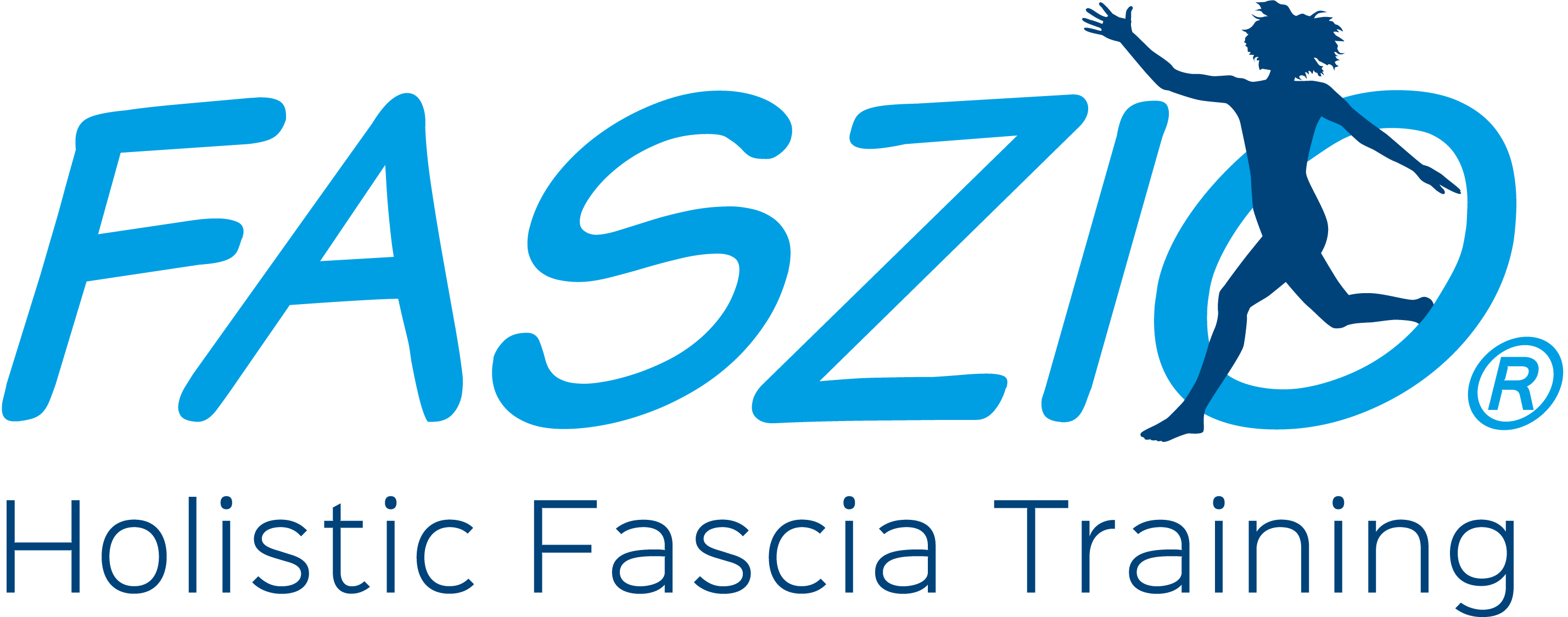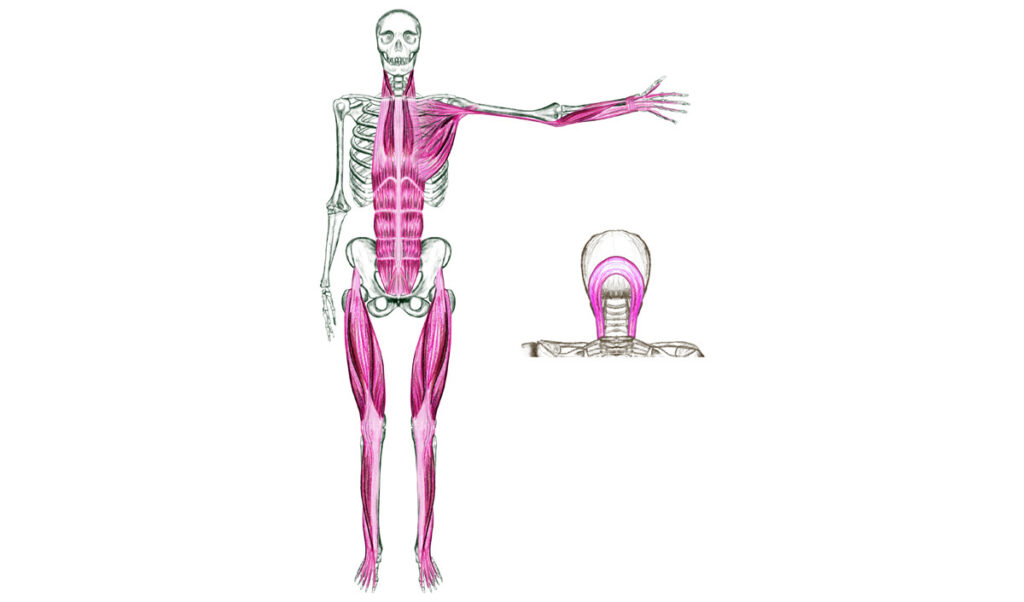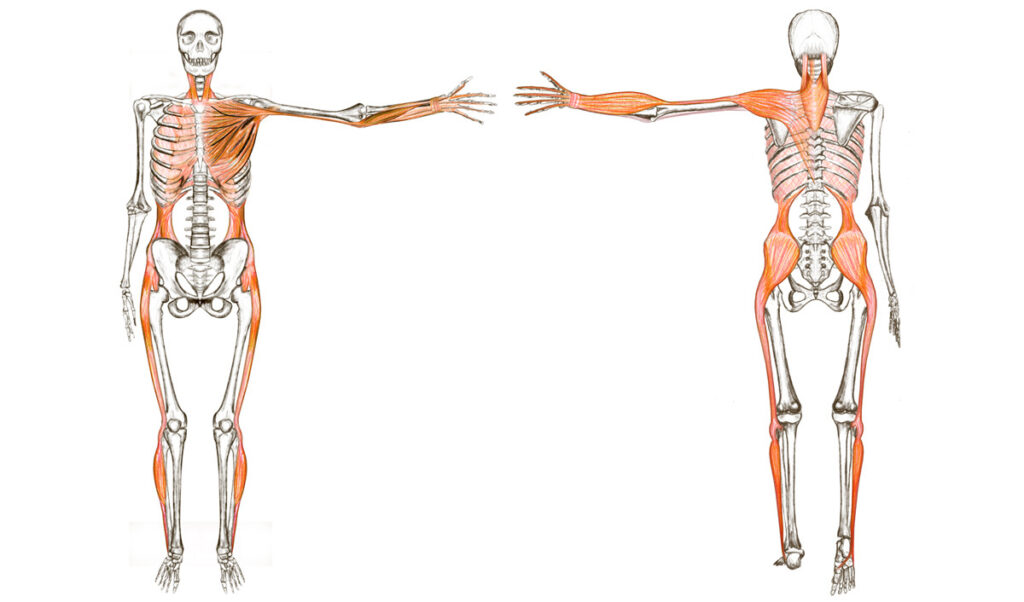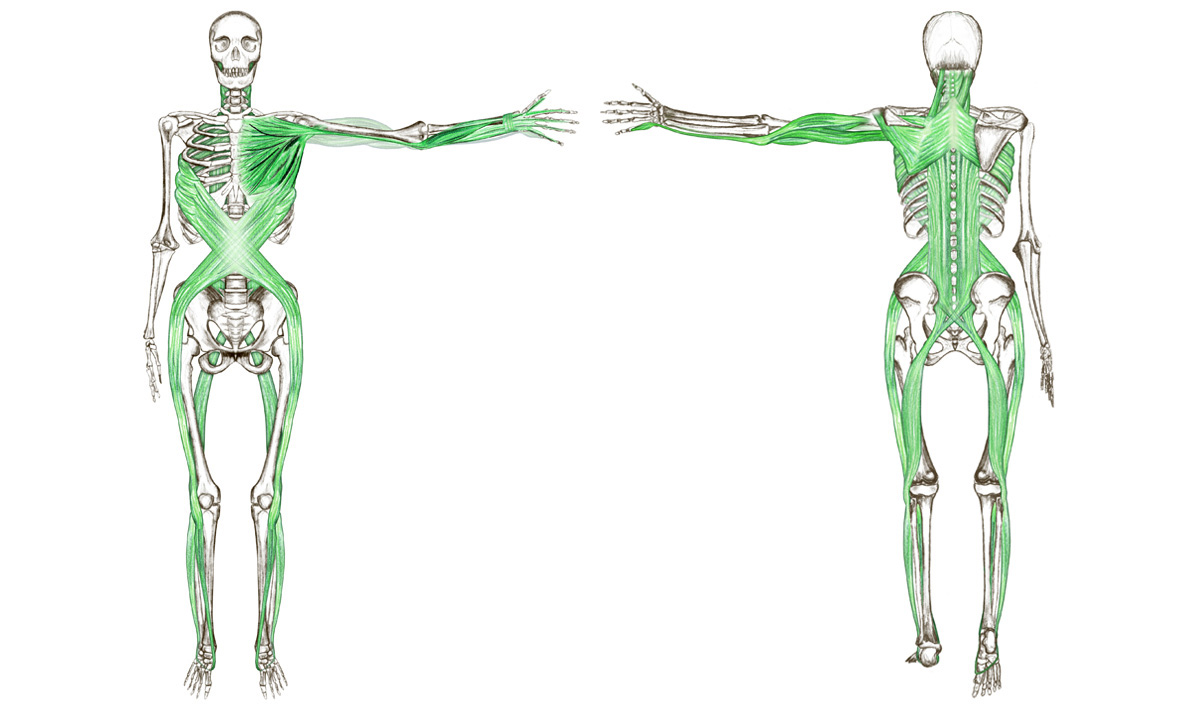Fascial pathways according to FASZIO®
a model for stretching and energy transfer in the body
Based on the “Anatomy Trains” by Thomas Myers, the FASZIO®concept works with the mental model of the fascial pathways. It supports healthy functionality and naturalness for every type of movement of the organism. Every power potential is provided economically, even at maximum load. If one compares the body-wide transmission of force with a road network, the 5 fascia pathways act as “highways”, on which stimuli travel from A to B in the most direct way. At the same time, these 5 pathways form the preconditions for a balanced upright posture with the ability to react flexible.
FASZIO® used this knowledge for its movement and therapy concepts in order to positively affect imbalances that have arisen in these fascial pathways.

Front pathway
process:
- from the back of the head a loop leads left and right over the head turners to the collarbone
- further over sternum fascia and straight abdominal muscles to the pubic bone
- pectoral muscle forms transition to arms: Traction transmission leads along the inner sides of the arms to the palms and inner sides of the fingers
- extends from the hip bones over the front of the thighs, kneecaps, shins and instep to the toes

Back pathway
process:
- from eyebrow bulges across the skull tendon plate to the back of the head
- hood muscle forms transition to arms: Traction transfer extends along the outside of the arm to the back of the hand and fingers
- pulls down over back extensor over sacrum to ischium
- over the back of the thighs laterally inside and outside to lower legs (below knee)
- from the thigh (above the knee) over calves, Achilles tendons, heels, soles of the feet to under toes

Side pathway(s)
process:
- from the back of the head the head-turning muscle pulls forward to the collarbone and the strap muscle pulls down to the first thoracic vertebrae
- from 1st and 2nd rib via intercostal into the arms and oblique abdominal muscles further to the pelvis from the iliac crest over the large gluteal muscle and tractus iliotibialis laterally over the knee on the lower leg down to the outer ankle
- over the outer edge of the foot through the transverse arch behind the ball of the big toe
(Description also applies to the other side)

Spiral pathway(s)
process:
from the front of your head down:
- begins on one side of the back of the head
- pulls down at the neck and crosses under the opposite shoulder blade, laterally around the torso, with a transmission into the arms, further into outer oblique abdominal muscles
- over the middle of the torso to the opposite side into inner oblique abdominal muscles to iliac bones
- continue via the iliotibial tract, laterally past the outer edge of the kneecap and diagonally over the shin to the inner side of the foot
down by the feet:
- forms stirrups under the foot: pulls from the inner side of the foot behind the ball of the big toe through the transverse arch to the outer edge of the foot
back up to the head again:
- from the outer edge of the foot behind the outer ankle laterally along the lower leg up past the knee to the structures of the back of the leg
- via ischium and sacrum in equilateral back extensor to the occiput
(Description also applies to the other side)

Central pathway
process:
The central pathway is much more complex than the more superficial pathways. In its course it stretches three-dimensionally around and through the abdominal and thoracic organs. Thus it forms the central “core” of the body. Roughly speaking, it can be divided into three areas that run three-dimensionally through the head and trunk, with a connection in the diaphragm and in the pelvis, where they join together to draw to the feet:
from the front of the head:
- extends over the temporal bone, large masticatory muscle to the hyoid bone, over the muscles of the pharynx to the internal structures of the sternum to the diaphragm
- transmission into the arms (via biceps along the spoke to the thumb) with the fascial structures of the chest
- via the inner abdominal wall fascia (fascia transversalis) via the pubic bone to the inner thigh
from middle of the head:
- extends from the back of the head and temporal bone via deep neck muscle to the pharynx incl. larynx via oesophagus and pleura visceralis incl. pericardium to the diaphragm
- via m. psoas major at the lumbar spine, including the deep hip muscles to the inner side of the thigh (makes hip flexion)
from the back of the head:
- extends from the back of the head via deep neck muscles as a fascial band along the inside of the spine to the sacrum; also connected to the diaphragm
- connection to the arms through the fascial structures of the chest
- from the inner side of the sacrum via the posterior parts of the pelvic floor including the m. piriformes via the ischial region to the inner side of the thigh
from torso to feet:
- from the inside of the leg (adductors) through the rear part of the knee capsule, deep through the lower leg to the rear inner ankle, deep through the sole of the foot to the toes
All areas always work together and are to be regarded as a unit! The subdivisions only serve for a better understanding of the path and complexity!








